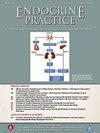老年1型糖尿病和成人潜伏性自身免疫性糖尿病(LADA)患者的技术使用和糖尿病管理,一项更好的登记横断面分析。
IF 3.7
3区 医学
Q2 ENDOCRINOLOGY & METABOLISM
引用次数: 0
摘要
目标:有关异质老龄人口糖尿病管理的真实世界数据仍然有限。本研究旨在概述 50 岁及以上 1 型糖尿病(T1D)或成人潜在自身免疫性糖尿病(LADA)患者的技术使用情况及其相关因素、糖尿病管理和社会心理方面的情况:这项横断面研究分析了加拿大 BETTER 登记处的数据,这些数据主要基于 T1D 或 LADA 患者的自我报告结果。对三个年龄组进行了比较分析:50-59 岁、60-69 岁和≥70 岁:参与者(n=674)主要为白种人(97-98%),居住在加拿大魁北克省(71-79%)。各年龄组使用胰岛素泵的比例相似(36-39%,P=0.822),而年龄≥70 岁者使用持续葡萄糖监测(CGM)的比例较低(50-59 岁和 60-69 岁均为 85% ,≥70 岁为 73%,P=0.020)。在其他因素中,拥有私人保险和居住在魁北克省以外与胰岛素泵和 CGM 的使用呈正相关。在所有组别中,达到 HbA1c ≤8% 的参与者比例都很高(80%-86%)。与年龄≥70 岁的参与者相比,年龄在 50-59 岁的参与者在最近一个月内发生 2 级低血糖的频率更高(6.9 vs 3.4,P=0.001)。各组之间的三级低血糖、社会和专业支持相似。有趣的是,老年组中与糖尿病相关的困扰较少:该队列中的大多数人都使用了技术,但年龄≥70 岁的人群中使用技术的比例较低。总体而言,各年龄组的糖尿病管理情况良好且相似。本文章由计算机程序翻译,如有差异,请以英文原文为准。
Technology Use and Diabetes Management Across Elder Age Groups in Type 1 Diabetes and Latent Auto-Immune Diabetes in Adults, a BETTER Registry Cross-Sectional Analysis
Objectives
Real-world data on diabetes management among a heterogenous aging population remain limited. This study aims to provide an overview of technology use and factors associated to its use, diabetes management, and psychosocial aspects experienced by adults aged 50 and over living with type 1 diabetes or latent autoimmune diabetes in adults.
Methods
This cross-sectional study analyzed data from the Canadian BETTER registry, mostly based on self-reported outcomes from individuals living with type 1 diabetes or latent autoimmune diabetes in adults. Comparative analyses were conducted across 3 age groups: 50-59, 60-69, and ≥ 70.
Results
Participants (n = 674) were predominantly Caucasian (97% to 98% across groups) and residing in Quebec, Canada (71% to 79%). Insulin pump use was similar across age groups (36% to 39%, P = .822), while continuous glucose monitoring was lower among those aged ≥ 70 years (85% for both 50-59 and 60-69 vs 73% for ≥ 70 years, P = .020). Among other factors, having private insurance and living outside of Quebec were positively associated with both insulin pump and continuous glucose monitoring use. A high proportion (80% to 86%) of participants achieved an HbA1c ≤ 8% across all groups. Level 2 hypoglycemia events in the last month were more frequent among participants aged 50-59 years compared to those aged ≥70 years (6.9 vs 3.4, P = .001). Level 3 hypoglycemia, social and professional support were similar between groups. Interestingly, diabetes-related distress was lower in older age groups.
Conclusions
Most individuals in this cohort adopted technology use but in lower proportion among the group aged ≥70. Overall, diabetes management was good and similar between age groups.
求助全文
通过发布文献求助,成功后即可免费获取论文全文。
去求助
来源期刊

Endocrine Practice
ENDOCRINOLOGY & METABOLISM-
CiteScore
7.60
自引率
2.40%
发文量
546
审稿时长
41 days
期刊介绍:
Endocrine Practice (ISSN: 1530-891X), a peer-reviewed journal published twelve times a year, is the official journal of the American Association of Clinical Endocrinologists (AACE). The primary mission of Endocrine Practice is to enhance the health care of patients with endocrine diseases through continuing education of practicing endocrinologists.
 求助内容:
求助内容: 应助结果提醒方式:
应助结果提醒方式:


